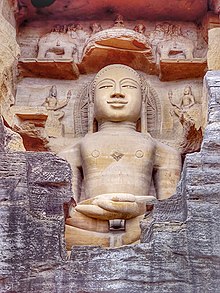This article needs additional citations for verification. (November 2016) |
| Gopachal Parvat Gopachal Rock-Cut Jain Monuments Gopachal Jain Colossi | |
|---|---|
 Carving of a Tirthankar | |
| Religion | |
| Affiliation | Jainism |
| District | Gwalior |
| Deity | Tirthankara |
| Location | |
| Location | Gwalior Fort |
| State | Madhya Pradesh |
| Country | India |
| Geographic coordinates | 26°12′55.1″N 78°10′02.9″E / 26.215306°N 78.167472°E |
| Architecture | |
| Style | Jainism |
| Creator | Tomars |
| Date established | 14th century (Kirti Singh Tomar) |
| Completed | 15th century (Dungar Singh Tomar) |
The Gopachal Rock-Cut Jain Monuments, or Gopachal Jain Colossi, also called Gop Parvat Jaina Monuments, are a group of gigantic and large proportionate Jain rock-cut carvings dated to between the 14th and 15th centuries. They are located around the walls of the Gwalior Fort, Madhya Pradesh. They depict Tirthankaras in seated Padmasana posture as well as standing Kayotsarga posture, in the typical naked form of Jain iconography.
The number of Jain rock shrines at Gwalior, with numerous monumental statues, is unmatched anywhere else. James Burgess wrote: "In the 15th century, during the reign of the Tomar kings, the Jains seem to have been seized with an uncontrollable impulse to convert the cliff that sustains the fort into a great shrine in honour of their religion, and in a few years excavated the most extensive series of Jaina caves known to exist anywhere."[1]
The Gopachal Jain Collosi is one of the Archaeological Survey of India's Adarsh Smarak Monument along with other monuments in the Gwalior Fort.[2]
- ^ Burgess 2013, p. 509.
- ^ "Adarsh Smarak Monument". Archaeological Survey of India. Archived from the original on 13 August 2021. Retrieved 19 July 2021.
